This was published 4 years ago
Elements of surprise in Museum of Contemporary Art's summer show
By Chloe Wolifson
If you've been missing attending exhibitions, Lindy Lee's absorbing Moon in a Dew Drop at the Museum of Contemporary Art is an opportunity well worth seizing.
The coronavirus pandemic dashed the gallery's plans for its annual international blockbuster, but Lee, one of our country's significant contemporary artists, is well deserving of the summer spotlight with her largest survey exhibition to date.
While many will be familiar with Lee’s public sculptures of scholar’s rocks and perforated orbs, Lindy Lee: Moon in a Dew Drop offers an introduction to, and reflection of, the artist’s practice, and her approach to life’s big questions, over four decades.
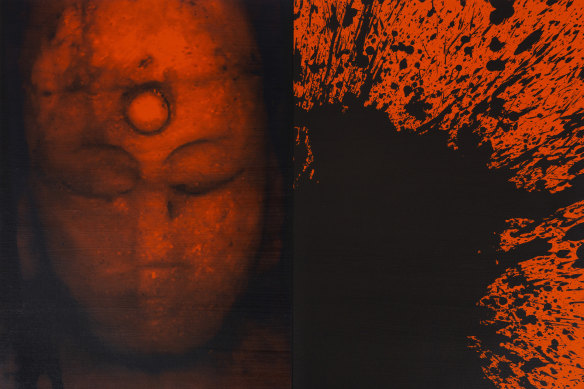
Lindy Lee's Moon in a Dew Drop.
Lee's work often explores her Australian and Chinese heritage, and the exhibition captures her sense of being caught between two cultures. Daoism and Ch’an (Zen) Buddhism are also central to Lee’s life and work (the exhibition’s title comes from writings of 13th century Zen philosopher Dogen). There are more than 70 works on display, from sculpture and installation to wax paintings and photocopy images.
Lee is known for her striking public sculptures and her new work Secret World of a Starlight Ember – a more than five metre wide polished stainless-steel sculpture pierced with thousands of tiny holes – has been installed outside the museum as part of the exhibition.
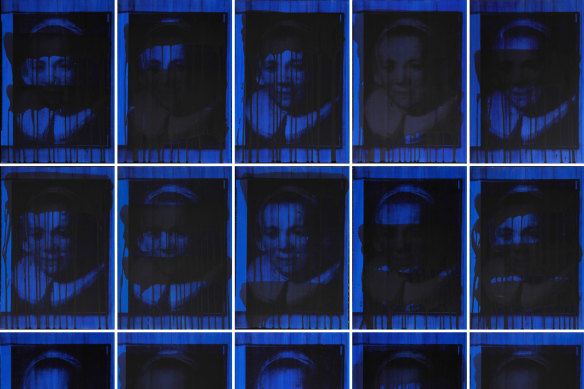
Lindy Lee's The Silence of Painters (detail).Credit: Courtesy Museum of Contemporary Art
Inside, the show begins with works from the mid-1980s in which Lee photocopied images of Renaissance paintings. These are juxtaposed with works Lee made this year from "flung" molten bronze. Lee's choice of materials is deceptively simple, how she uses them reveals deep consideration. In the photocopies, faces painted by van Eyck and Titian peer out through layers of toner, mis-registered and blurred. These introduce us to Lee’s grappling with her sense of identity as Australian and Chinese, being neither quite one nor the other, or a "bad copy" as she has put it.
In the next room, a series of paintings in which images of Renaissance artworks are excavated from dark waxy surfaces epitomise the way Lee uses gestures of vigour, dynamism and even violence yet resolves them with a quiet aesthetic strength.
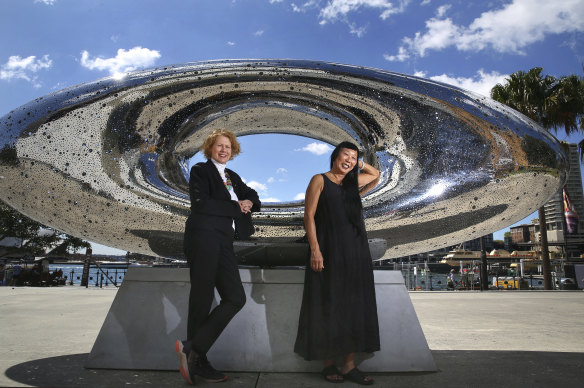
MCA director Liz Ann Macgregor and artist Lindy Lee. Credit: James Alcock
The exhibition traces Lee’s shift from using found images from art history to photographs from her family archive. A powerful example is Birth and Death, an installation of concertinaed images from past generations of Lee’s family. Here, as in other works from this time, colour is used simply yet to powerful effect, energising archival imagery that could otherwise seem inert.
At the far end of the gallery, No Up, No Down, I am the Ten Thousand Things sees Lee’s "flung ink" paintings burst like confetti across the gallery. The oblongs scattered over the walls, ceiling and floor are a visual shock, their corners released from neat formation, floating and jostling.
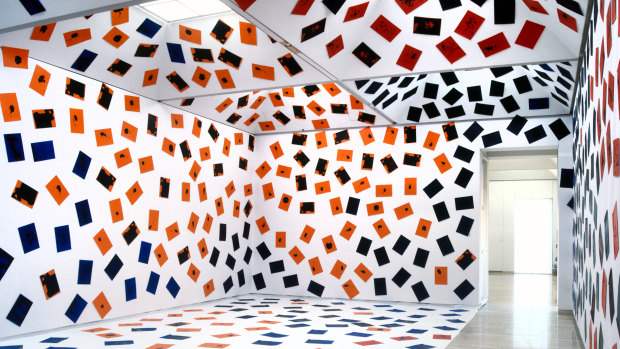
Lindy Lee's No Up, No Down, I Am The Ten Thousand Things.Credit: Courtesy Lindy Lee and Sutton Gallery Melbourne
While Lee's multi-panel works draw connections between abstract expressionism and mediation, her more recent works feature thousands of holes bored in paper and metal. Her new work Moonlight Deities is a large-scale example. Metallic-looking perforated paper is suspended throughout the space, casting cog-like shadows that envelop the viewer.
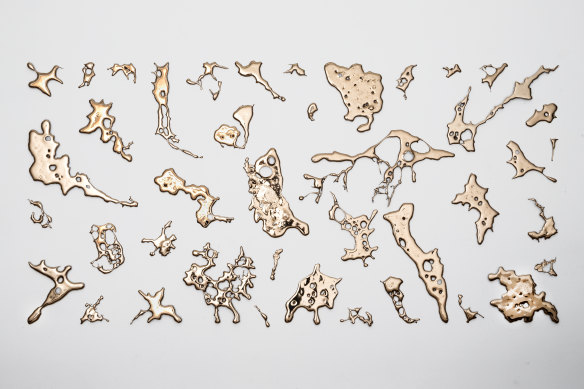
Lindy Lee's Reality Prior to Heaven and Earth.
Further on, more delicate works on paper contain holes formed by fire and left in the elements. Water and fire are used in a literal sense in Lee’s practice, but elemental qualities are also captured in Lee’s overall approach to materials and processes – flung ink, flung bronze, burnt holes, cast shadows. The title of the exhibition refers to the microcosmic and macrocosmic, not only in terms of scale but also time – the fleeting moment in which ink or bronze is flung, and the thousands of years over which a scholar’s rock is forged.
One doesn’t have to be familiar with Buddhist philosophy to feel the impact of these ideas. Lee’s deep understanding of Zen concepts translates into beautiful artworks which resonate with shared humanity. Her works are an exploration of her own identity but they speak to every individual’s process of searching for who they are.
This review is supported by the Copyright Agency’s Cultural Fund and the Judith Neilson Institute for Journalism and Ideas.